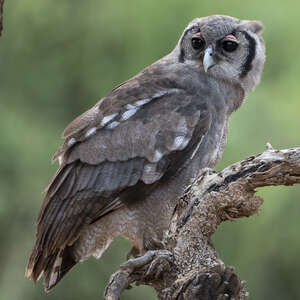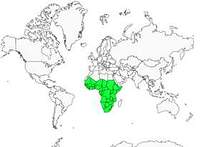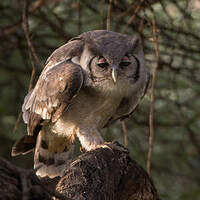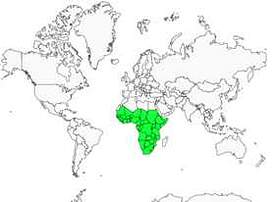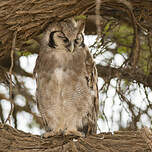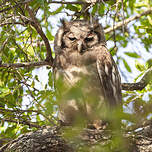Verreaux's Eagle-Owl
Ketupa lactea - Grand-duc de Verreaux
Identification
Verreaux's Eagle-Owl is the largest nocturnal raptor in Africa. Its name comes from French ornithologist Jules Verreaux (1807-1873) who was very early attracted to birds and animals, his father being a taxidermist. This nocturnal raptor ranks 3rd among the world's nocturnal raptors, behind Blakiston's Fish-Owl in Asia and the Eurasian Eagle-Owl. A large raptor, the female can weigh up to 3.1 kg while the male will only weigh about 2 kg, the stronger sex is not always the one you think it is! Once spotted, it is recognizable by its two tufts of feathers, which may be more or less long depending on individuals. The head shows a distinct black facial circle, slightly bordered by white, this circle encompassing the entire face which is milk-white and extending down to the beak of greyish white color and marking the upper edge of the eyes. Thin black hairs form a mustache on either side of the beak. But the distinctive mark of the Verreaux's Eagle-Owl is the pink of its eyelids, which it does not always show, above huge black eyes. The forehead is light grey or milk-white (Bubo lacteus!), slightly striped with horizontal dark bands, the neck, chest and belly, of the same color present the same stripes. The mantle and back are light brown-grey with white tints. White vertical stripes mark the wings, especially at the edges of the scapulars and median flight feathers, the same type of smaller white bands marking the tertiary remiges. Generally, the ends of the coverts are also white, even though these marks can be absent in some individuals. In flight, the upper coverts are whitish with gray marks while the remiges are gray, separated from each other by a white line; seen from below the coverts are practically white, with gray stripes crossing the ends.Young ones have a lighter plumage that is more towards brown, the puffs of ear tufts are almost not visible and the facial disk is less pronounced. Generally, the bird shows less of its legs often masked by the plumes of the lower abdomen, when the Verreaux's Eagle-Owl stands, one sees powerful talons and thick tarsi visibly muscular.
Subspecific information monotypic species
Foreign names
- Grand-duc de Verreaux,
- Búho lechoso,
- bufo-leitoso,
- Blassuhu,
- Verreaux-uhu,
- Verreaux' Oehoe,
- Gufo reale di Verreaux,
- mjölkuv,
- Gråhubro,
- výr belavý,
- výr bělavý,
- Savannehornugle,
- savannihuuhkaja,
- Reuse-ooruil,
- duc lletós,
- puchacz mleczny,
- Бледный филин,
- クロワシミミズク,
- 黄雕鸮,
- mjölkuv,
- 乳黃色鵰鴞,
Voice song and call
Verreaux's Eagle-Owl does not really have a song, it growls, producing gwook, gwook regularly. It also emits high-pitched whines that can be heard from far away. When the female is incubating her or her young, she produces shrill cries with the brood to call the male and demand food.
Habitat
He likes savannas dotted with spiny bushes, airy forests that allow him to perch on tall trees and that can be home to his nest. He avoids too dense forests, which would hinder his flight. Close to rivers and marshes. It is estimated that he needs about 7,000 ha to be comfortable. Verreaux's Eagle-Owl is accustomed to these settings.
Behaviour character trait
Dietfeeding habits
Anglo-Saxons identify Verreaux's Eagle-Owl as an Apex predator, meaning the top predator in its territory's food chain.
It will hunt all types of prey: reptiles, insects, small to medium-sized mammals, all rodents, mongooses, monkeys, very adept at hedgehogs that it knows to peel! It has been seen attacking small warthogs! All birds are potential prey in the air or on the ground: passerines, waterfowl, flamingos, other smaller raptors or snake-eating birds. Its varied diet makes it a fisher when near water sources. Its hunting periods being the twilight and the night, its only aerial competitors, the large eagles such as the Martial Eagle or the Crowned Eagle, do not compete since they are diurnal.Reproduction nesting
From March to September, especially from June to August in Eastern Africa and from January to March in Western Africa, the Verreaux's Eagle-Owl will often use the old nests of other birds such as eagles, vultures, snake-eagles or African harriers, with observations happening in shrike's nests! They can also use holes in large trees.
If the couple settles in happily, they will return to the same locations for each breeding period. One to two eggs are incubated by the female and the incubation period is 32-39 days, with chicks hatching with a 7 day interval. The raising of the two chicks is cruel, often the youngest one dies of hunger or is killed by the oldest. The mother almost literally tends to the little one for around twenty days, with the male continually bringing food to his mate which will tear apart the prey and feed her/his chick(s). The young are ready to vacate the nest in around sixty days, but they will still wait another two weeks before learning to fly; they will stay inactive for roughly three months, entirely dependent on their parents for food. The young seem to enjoy being in a family and can stay up to two years close to the couple and their nest! Observations have shown that the teenagers are helping their parents in nourishing a second or even third brooding. The breeding frequency is not well known but supposedly dependent on the abundance of prey, with sexual maturity arriving at age 3-4.Geographic range
This raptor is mostly found in Eastern Africa: Botswana, Kenya, Namibia, Tanzania, Zambia, Zimbabwe, and further north, observed in Somalia and Ethiopia, some individuals are spread across South Africa, others in Lesotho where they may have recently disappeared. This raptor remains present in Western Africa, but scattered: Senegal, Gambia, Cameroon, Sierra Leone, but these populations see their territories diminish.
Threats - protection
IUCN conservation status
concern
in the Wild
threatened
evaluated
Overall, the Verreaux's Eagle-Owl does not appear to be in danger globally, but its situation seems to differ from one country to another. In West Africa, in Senegal and Gambia, it seems to be approximately protected and to be thriving properly. However, the situation is more delicate in Sierra Leone, Liberia and Ghana, where it is not considered or respected; just take a look at the photo taken in Bamako's market in Mali on the pictures of the website! On the other hand, the national and private reserves of East Africa - Botswana, Kenya, Tanzania, Zambia, Zimbabwe - give him the vast territories that he needs. Man must pay attention to the largest African nocturnal raptor which is a jewel of wildlife and of the ornithological universe in order for its status not to become more critical.
Sources of information
- IOC World Bird List (v15.1), Gill, F and D Donsker (Eds). 2025-12-07.
- Birds of Kenya and Northern Tanzania, Dale A Zimmerman, Donald A Turner, David J Pearson
- Birds of Southern Africa, Ian Sinclair, Phil Hockey, Warwick Tarboton
- Field Guide Birds of Southern Africa, Ian Sinclair
- Vol. 5 - Handbook of the Birds of the World, Josep del Hoyo-Andrew Elliott-Jordi sargatal
- ARKive, Christopher Parsons
- Bird e-Guide,
- Global Raptor Information Network,
- THE AVIANWEB, Sibylle Faye
- Wikipédia, Wikipedia, The Free Encyclopedia
Other sources of interest
 Specification sheet created on
30/07/2023 by Anne et Gabriel Leboff
Specification sheet created on
30/07/2023 by Anne et Gabriel LeboffTranslation by AI Oiseaux.net
© 1996-2026 Oiseaux.net
- Accipitriformes
- Aegotheliformes
- Anseriformes
- Apodiformes
- Apterygiformes
- Bucerotiformes
- Caprimulgiformes
- Cariamiformes
- Casuariiformes
- Charadriiformes
- Ciconiiformes
- Coliiformes
- Columbiformes
- Coraciiformes
- Cuculiformes
- Eurypygiformes
- Falconiformes
- Galliformes
- Gaviiformes
- Gruiformes
- Leptosomiformes
- Mesitornithiformes
- Musophagiformes
- Nyctibiiformes
- Opisthocomiformes
- Otidiformes
- Passeriformes
- Pelecaniformes
- Phaethontiformes
- Phoenicopteriformes
- Piciformes
- Podargiformes
- Podicipediformes
- Procellariiformes
- Psittaciformes
- Pterocliformes
- Rheiformes
- Sphenisciformes
- Steatornithiformes
- Strigiformes
- Struthioniformes
- Suliformes
- Tinamiformes
- Trogoniformes

